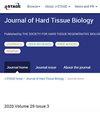顺铂诱导的Sonic Hedgehog信号传导介导Hertwig上皮根鞘细胞上皮-间质转化
IF 0.4
4区 医学
Q4 ENGINEERING, BIOMEDICAL
引用次数: 0
摘要
在这项研究中,我们通过基因敲低的方法确定了顺铂是否可以通过激活小鼠Hertwig上皮根鞘(HERS)细胞中的Sonic hedgehog (Shh)或胶质瘤相关抗原-1 (Gli1)信号通路来诱导上皮-间质转化(EMT)。低浓度顺铂(0.5µM)处理24 h后,细胞活力未降低;然而,与未处理的对照细胞相比,γ - h2ax染色的nu clear百分比显著增加,表明0.5µM顺铂诱导DNA损伤。此外,0.5µM顺铂处理的细胞诱导EMT,分别显示上皮和间充质标志物的表达减少和增加。顺铂处理的HERS细胞中EMT活性的增强与Shh表达的增加以及Gli1表达在细胞核中的易位和积累加速相关。RNA干扰介导的Gli1沉默抑制顺铂处理的HERS细胞中EMT的加速;E-cadherin和vimentin的表达分别没有下调和上调,Snail的表达也没有增加,证实了这一点。这些发现表明,Shh/Gli1信号通路的激活可能是增强顺铂处理的HERS细胞EMT的必要条件。通过DNA损伤激活Shh/Gli1信号通路。(a)低浓度的顺铂(0.5µM)诱导DNA损伤;然而,这种浓度不会降低细胞活力;(b)分别通过下调和上调上皮和间充质标志物的表达来检测顺铂诱导的EMT;(c)顺铂处理的HERS细胞Shh和Gli1表达增加;(d)将Gli1 siRNA转染到HERS细胞中,可以明显抑制顺铂诱导的EMT。本文章由计算机程序翻译,如有差异,请以英文原文为准。
Cisplatin-Induced Sonic Hedgehog Signaling Mediates Epithelial-Mesenchymal Transition in Hertwig’s Epithelial Root Sheath Cells
: In this study, we determined whether cisplatin can induce epithelial-mesenchymal transition (EMT) via the activation of Sonic hedgehog (Shh) or glioma-associated antigen-1 (Gli1) signaling pathway in mouse Hertwig’s epithelial root sheath (HERS) cells using a genetic knockdown approach. HERS cells treated with a low concentration of cisplatin (0.5 µM) for 24 h showed no reduction in the cell viability; however, there was a significant increase in the percentages of nu clear staining with γH2AX as compared to that with untreated control cells, indicating that 0.5 µM cisplatin induces DNA damage. Further, 0.5-µM cisplatin-treated cells provided an induction of EMT, showing decreased and increased expression of epithelial and mesenchymal markers, respectively. Enhancement in the EMT activity in cisplatin-treated HERS cells was correlated with increased expression of Shh and accelerated translocation and accumulation of Gli1 expression into the nucleus. The RNA interference-mediated silencing of Gli1 suppressed the acceleration of EMT in cisplatin-treated HERS cells; this was confirmed by no down-regulation or up-regelation in the expression of E-cadherin and vimentin, respectively, along with no increased expression of Snail expression. These findings suggest that the activation of Shh/Gli1 signaling pathway may be required for the enhancement of EMT in cisplatin-treated HERS cells. concentration the activation Shh/Gli1 signaling pathway by of DNA damage. by the following observations: (a) low concentration of cisplatin (0.5 µM) induces DNA damage; however, this concentration does not reduce the cell viability; (b) cisplatin-induced EMT is examined on the basis of downregulated and up-regulated expression of epithelial and mesenchymal markers, respectively; (c) the cispla-tin-treated HERS cells increased Shh and Gli1 expressions; (d) Transfection of Gli1 siRNA into the HERS cells reveals a significant suppression of cisplatin-induced EMT.
求助全文
通过发布文献求助,成功后即可免费获取论文全文。
去求助
来源期刊

Journal of Hard Tissue Biology
ENGINEERING, BIOMEDICAL-
CiteScore
0.90
自引率
0.00%
发文量
28
审稿时长
6-12 weeks
期刊介绍:
Information not localized
 求助内容:
求助内容: 应助结果提醒方式:
应助结果提醒方式:


